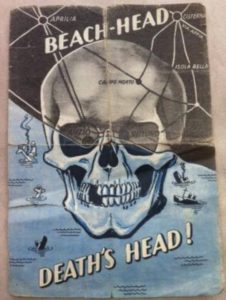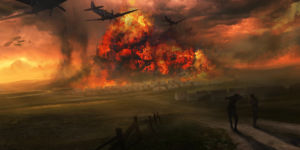
Dunkirk is not a historical fiction movie. It is a war movie. With the weight of WWII history behind it, you might have gone into the theatre expecting a dramatized story filled with terrors of battles, personal conflicts, a stand-off between good and evil, perhaps even a dash of romance. But Christopher Nolan chose a different route. At its core, Dunkirk is a picture of war reenactment. It is an invitation for the audience to experience what it feels like at the moment when the enemy is closing in, and all you’ve got to hold on to is hope.
Reenactment brings to mind badly produced TV footage complete with atrocious acting and cheaply designed costumes and sets. All that changed under Nolan’s masterful hand. Supported by a stellar cast and a blockbuster-size budget, Nolan gave us a sensory spectacle. The astounding, magnificent scenery of the expansive beaches and the sea. The precision sound of gunfire and weapons. The nerve-wracking background beats that remind you your very life is on the line. If Nolan had the technology, he would’ve let us smell the explosions and taste the oil in the ocean water too.

Having written five books set in historical times, I know a thing or two about including historical details when telling a story, and I was awestruck by everything I’d seen throughout this film. Nolan’s meticulous attention to the most minute of details rivaled James Cameron in Titanic. Dunkirk begins with a group of British soldiers walking warily down a deserted street. Propaganda leaflets rained from the sky, intended to instill fear. I immediately thought of the German propaganda flyers I’d seen when I was researching for my own WWII series Rose of Anzio. I had written this detail into my story too. In the movie, the scene with the leaflets lasted only a few seconds. For the viewers, it might amount to nothing but an afterthought. But such details are the ingredients for giving the audience a rich, immersive experience, and I appreciate Nolan’s efforts in this regard.
From this point on, the tension in the movie never lets up. Gunfire breaks out, and we follow a soldier who escaped and survived. The soldier (played by Fionn Whitehead) appears no more than twenty years old. This is another detail that I liked. Too often, Hollywood casts older actors to star in WWII films based on the actors’ bankability and star power. But in fact, WWII was a war fought by young men barely into their adulthood. It is the reason why people in that era called their soldiers “the boys”. By casting Fionn Whitehead and Harry Styles as the everyman soldier, Nolan pointedly reminded us of the tremendous waste of young lives in WWII.
I didn’t know the young soldier’s name was Tommy until I read about it afterward. The movie never identified who was who except for a civilian teenage boy named George who had joined the rescue mission. Dunkirk is a not a film with story arcs that evolved around characters. It doesn’t even really have a plot, and the dialogue is best described as minimalistic. What we’re shown is a reenactment of what the British did on the land, at sea, and in the air, to survive and escape.
Some critics have said the movie failed for its lack of historical context. For example, it tells us nothing about Dunkirk’s significance as part WWII history, or how this military retreat came about and what consequences it held for the Allies in the future. This criticism has its merits. I myself was taken aback when the first shots of the movie gave us simple text explaining that the Germans had cornered the BEF in Dunkirk. For a blockbuster film of this scale, I had expected more than a written explanation. The computerized fonts on screen felt out of place. I thought I was being set up for a monumental disappointment.
My worries were unfounded. It became obvious very quickly that this was not a movie about the history behind the evacuation, but the evacuation itself. The terror and fight for survival that happened here could’ve happened in any war, be it a war in the old days of medieval Europe or the ancient Mediterranean and Asia, or more modern-day Vietnam and Iraq. As we watch Tommy and his fellow soldiers’ escape attempts being thwarted again and again, we could feel every inch of their fear and desperation. Since I began writing WWII novels, I’d read a lot about life in battle and consulted with a number of veterans who had kindly helped and advised me in writing my battle scenes. I came to see how detached our civilian population’s realities are to the lives of those who served. PTSD and inadequate medical care for our veterans are serious problems that our society continues to ignore. Here, in Dunkirk, Nolan lets us experience as much as we could the dangers that our soldiers have to face. Through the rescued soldier (nameless and wonderfully played by Cillian Murphy), Nolan reminds us the psychological trauma they suffer.

It would be incorrect to say that this movie is devoid of WWII history. It will certainly delight history buffs who make it a hobby to obsess with WWII war plane models, shells, uniforms, and the like. Throughout the film, Nolan also weaved in true aspects of this war, many of which I had also written about in my story to lend it authenticity. For example, I knew about the shrill sirens of the German warplanes from my research. I had described them in my books, and it was amazing to hear these sounds reproduced with what is no doubt first-rate sound technology. I was also fascinated by Nolan’s depiction of the German aerial attack of a medical ship. In Rose of Anzio Book 3 – Desire, I had written a scene with Luftwaffe planes attacking a medical ship. The scene was based on the German aerial attack of the medical ship SS St. David at Anzio Beach on January 24, 1944. In this movie, Nolan brought together all these pieces of WWII military history and tied them into a coherent whole for us to not only witness, but also to sense and feel.
There has been some controversy about the lack of representation of women and minorities in this film. When I watched the film, I didn’t get that reaction at all. In true historical context, WWII was a war fought mainly by men. Therefore, the lack of women in a film about escaping soldiers didn’t bother me much. Besides, extensive screen time doesn’t necessarily equate representation. As a director, Nolan is more than capable of making a point without having to draw things out. In Dunkirk, we see an army nurse on the medical ship frantically trying to save a wounded soldier while bracing for imminent enemy attack along with the men. In another scene, we saw for a split second the sight of a woman standing on board a small civilian vessel coming to the rescue. With just two brief scenes, Nolan made a forceful assertion that women were equally brave and contributed no less to the rescue efforts.
I recalled seeing one black soldier. To be honest, I don’t know how big a role minorities played in the British military back then. I know that the U.S. military was racially segregated for most of WWII. When I see WWII movies that are made today where the troop consists of a rainbow coalition representation of all people, it does make me cringe. Not only is it historically inaccurate, it actually whitewashes a grave historical social injustice by pretending that minorities were integrated as equals.
Overall, Dunkirk was a one of a kind movie watching experience. I would certainly recommend it. If there is any element about it that loses points with me, it would be that the cinematography looked too high definition. Maybe I’m just used to seeing WWII movies that look brown, grainy, and vintage. I couldn’t help but wonder if a RAF pilot flying in the sky saw the war planes in the same lush colors as we saw them in the film. I wonder if WWII movies made by Hollywood will all look like this from now on. To Nolan’s credit, he avoided using CGI. Still, this movie felt too pretty. It was stylized to the point where you could forget the true visual horrors of war that a soldier might see. If Nolan had wanted to give us a full immersive experience, then the view as shown through modern video technology had, in a way, defeated that purpose.
Lastly, a few words about the big elephant in the room. For weeks leading up to the movie opening, I’d been amused by the explosion of tweets about Harry Styles on Twitter. In fact, he’s the only actor in the film to have his own dedicated Dunkirk movie news Twitter page (Harry Dunkirk News @StylesMoviesNews). Maybe those of us who are older (and not necessarily wiser) were waiting for him to bomb (pun intended). In this movie, he was fine. This is not my subjective opinion either. The fact that my husband, who had worked in the movie industry once upon a time, asked me three times, “Which one was Harry Styles?” after we saw the movie was solid proof that Styles did not stand out as the only one who “can’t act” among the superior cast. In retrospect, I’m very glad that Nolan included him in this film. WWII is too important an event to be forgotten. There are still many lessons to be learned from this war. If Harry Styles can get the younger generation to become more interested in WWII, then what’s wrong with that?
Today is the final day of the Dunkirk Week WWII Epic Book Sale. From July 21-27, more than 50 fiction authors from the Facebook Second World War Club have joined together to bring to you riveting tales of WWII, most for a discounted price of 99c. Our novels range from military war tales, home front drama and sagas, harrowing accounts of the
Holocaust, gripping spy thrillers, moving wartime romances, and much, much more. If you haven’t seen it yet, be sure to check it out at www.alexakang.com/dunkirk-book-sale/
Moonlight, Book one of my WWII series, Rose of Anzio, is also offered in this Dunkirk Book Sale for 99c this week only. It is an epic love story that spans from pre-war Chicago to the heroic Battle of Anzio in Italy and beyond. I hope you’ll check it out.





